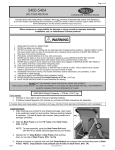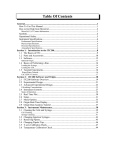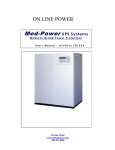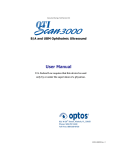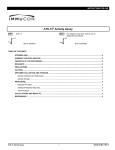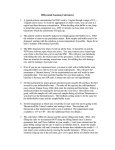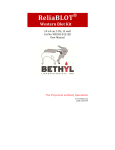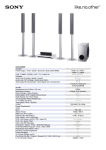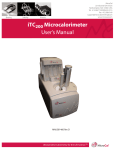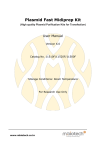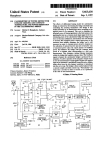Download User`s Manual - MikeBlaber.org
Transcript
DSCFIT © Flexible, Rapid and Automated Analysis of Differential Scanning Calorimetry Data USER'S MANUAL Version 15.3 3/25/2002 Sasha B. Grek, John K. Davis and Dr. Michael Blaber Institute of Molecular Biophysics Florida State University Tallahassee, FL 32306-4380 TEL: (850) 644-5870 FAX: (850) 561-1406 [email protected] This work was supported by a grant from the Florida Space Grant Consortium http://wine1.sb.fsu.edu/DSCfit/ DSCFIT © v.15.3 User's Manual 03/25/2002 http://wine1.sb.fsu.edu/DSCfit/ Table of Contents Program Description System Requirements and Limitations How to Use this Manual Section 1: General Steps in Data Analysis I. Loading of Data II. Initial Guess of Thermodynamic Parameters III. The Graphs Dialog Box IV. The Refine Dialog Box Section 2: Description of Thermodynamic Parameters I. A0, B0, C0 II. A1, B1, DC III. DD IV. TD V. K Section 3: Available Models I. CN(T) II. CD(T) III. DCTD IV. DDTD and TD V. k Section 4: Advanced Topics I. Data Clipping II. Evaluation of Non-2-state Behavior III. Use of Second-order Polynomial Functions for CN(T) or CD(T) IV. Determination of Thermodynamic Constants at Temperatures other than TD V. More than One Possible Solution for Refined Parameters VI. Situations Where TD Does Not Exist Section 5: Derivations Section 6: Output of Function Data for Use in Other Programs 2 2 2 References Referencing DSCFit in your publications 29 29 1 3 4 5 6 8 8 9 9 9 10 10 10 11 11 11 13 18 20 20 21 22 28 DSCFIT © v.15.3 User's Manual 03/25/2002 http://wine1.sb.fsu.edu/DSCfit/ Program Description DSCFIT is designed to analyze data from differential scanning calorimetry (DSC) experiments. It uses a statistical mechanics-based two-state model in combination with an optimized non-linear least-squares fitting routine. The program is designed to be flexible, rapid, and require a minimum of operator intervention. By setting appropriate parameters, users can customize the type of model to be used in fitting the data. DSCFIT has the unique ability to evaluate concentration errors in DSC data, in addition to the determination of van't Hoff and calorimetric enthalpies. System Requirements and Limitations DSCFIT is a Windows™ 95/98/NT based program. A graphics display of at least 800x600 is required. A minimum of 32 MB of system memory is also required. The disk space requirements of the program are quite modest (currently <5 MB). As currently implemented, DSCFIT can analyze data sets with 2000, or fewer, data points. Data from both upscan and downscan experiments can be analyzed. Please report all bugs, etc. to: Dr. Michael Blaber Institute of Molecular Biophysics Florida State University Tallahassee, FL 32306-4380 TEL: (850) 644-5870 FAX: (850) 561-1406 [email protected] Suggestions for improvements to DSCFIT are also welcome. How to Use this Manual If you are ready to analyze a data set, proceed to section 1 (General Steps in Data Analysis). General descriptions of thermodynamic parameters are found in Section 2, and derivations of the thermodynamics parameters are found in Section 5. Section 3 (Available Models) and Section 4 (Advanced Topics) provide information on the various features of the program and their application in data analysis. 2 DSCFIT © v.15.3 User's Manual 03/25/2002 http://wine1.sb.fsu.edu/DSCfit/ Section 1: General Steps in Data Analysis I. Loading of Data The DSC data to be analyzed in DSCFIT should be a finalized molar heat capacity data file. In other words, it should be a protein/buffer run that has had the buffer/buffer run subtracted, and then been normalized for the molar concentration of the protein (although, as discussed in the Advanced Concepts section, DSCFIT can determine the apparent molar concentration with certain assumptions). The data file should be a text file consisting of two columns: the first column will contain the temperature data, and the second column will contain the corresponding values for the molar heat capacity. These columns of data may be separated by either a space (or spaces) or a tab character. DSCFIT will not currently parse data delineated by other characters (e.g. commas). The temperature can be either in °C or K, and the molar heat capacity can be in either calorie or Joule units (DSCFIT works internally with K and Joules, however). Load data by using either the File→Load Data menu command, or the "Load Data" command on the menu bar. A dialog window will open enabling you to specify the desired data file (the default file extension is *.dat). When reading in the data file, DSCFIT will present you with a dialog box to allow conversion of °C or calorie-based data to K and Joules: Select the appropriate radio buttons for the units of the input data (in cases where the temperature appears to be in °C rather than K, DSCFIT will alert the user to the need to convert). The temperature and heat capacity units are independent. Thus, if for some bizarre reason your raw data is in °C and Joules, select the radio buttons for Celsius and Joules. 3 DSCFIT © v.15.3 User's Manual 03/25/2002 http://wine1.sb.fsu.edu/DSCfit/ After reading the data file, DSCFIT will report the number of successfully imported data points, and the temperature range of the data: Before continuing, be sure that this information is as expected for the data file in question. Note: Currently, DSCFIT applies the conversions of K=(273.15+°C), and Joules=(calories/4.184) directly to the data when imported. If a mistake is made with the units when importing the data, close the project window and read in the data file again. II. Initial Guess of Thermodynamic Parameters After reading in a data file DSCFIT will automatically determine an initial guess for the various thermodynamic parameters, and report these values in the Parameters Dialog Box: 4 DSCFIT © v.15.3 User's Manual 03/25/2002 http://wine1.sb.fsu.edu/DSCfit/ At this point you can simply click 'OK' to accept the program's initial guesses for the parameters. Alternatively, you can modify any of the parameters. Checking the left-hand side box next to a parameter will constrain the parameter during refinement to the value indicated in the right-hand side box. Leaving the lefthand side box unchecked will allow the value of the parameter to vary during refinement to improve the agreement of the model with the data. Three parameters, A0 (the second order term for the native state heat capacity function), A1 (the second order term for the denatured state heat capacity), and k (the concentration constant) are constrained (as indicated by the appropriately checked box) to values of 0, 0, and 1, respectively. The text descriptions of these parameters are also boxed, to indicate that refinement of these parameters may be justified only under certain circumstances. III. Graphs Dialog Box After assignment of the initial values for the various thermodynamic parameters DSCFIT will display the Graphs Dialog Box: The Graphs Dialog Box allows you to select the appropriate thermodynamic function(s) for viewing as a graph. The graph chosen will be actively updated during the refinement cycle. The available functions include: Raw Data and Fit Curves - this graph will include the raw data an can also include the functions for the native state heat capacity function, denatured state heat capacity function as well as the fitted function based upon the current values of the various thermodynamic variables. This is the default graphic representation. Residual Scatter Plot - this graph shows the disagreement between the fitted function and the raw data. It is useful for determining the magnitude of the error (i.e. whether it is within the expected instrumentation noise level) and whether the error is random, or systematic (indicating possible non-2-state behavior). 5 DSCFIT © v.15.3 User's Manual 03/25/2002 http://wine1.sb.fsu.edu/DSCfit/ Delta Cp, Delta H, Delta G, Delta S - plots for these thermodynamic functions. On the left-hand side of the Graphs Dialog Box are parameters used in graphic the various functions. The default values are to autoscale Y, and the temperature range is the minimum and maximum of the data points. V. Refine Dialog Box After the appropriate graph has been selected the graph will be shown, along with the Refine Dialog Box: The Refine Dialog Box allows you to select the criteria for convergence of the model fit to the experimental data. The choices include: 1) refine for a fixed number of cycles, or 2) refine until no further improvement in the merit function is observed over a given number of refinement cycles, or 3) refine until the improvement in the merit function decreases to a specified value, or 4) refine until the standard deviation of the fit decreases to a specified value. Additionally, there is a button labeled Coefficients. Selecting this button will bring up the Coefficients Dialog Box (where the values of the various thermodynamic parameters can be manually entered, or the constrain check boxes may be selected or deselected). Clicking the button labeled 'Begin' will start the refinement of the thermodynamic parameters (to improve the fit with the raw data). The refinement will proceed until the selected criteria for convergence has been met. If more than 100 cycles of refinement are performed without the convergence criteria being met, the program will exit from refinement with an alert message. 6 DSCFIT © v.15.3 User's Manual 03/25/2002 http://wine1.sb.fsu.edu/DSCfit/ Statistical information on the refinement is available within Error Analysis section of the Refine Dialog Box: The information includes: 1) the value of the χ2 merit function, 2) the last value observed for the change in the merit function, 3) the standard deviation of the fit to the experimental data, and 4) the number of iterations that have occurred since an improvement in the merit function was observed. Each time the refinement routine identifies values that improve the agreement of the model with the raw data the currently displayed graph will be updated. When is the refinement of the thermodynamic parameters complete? As refinement proceeds, the value for the χ2 merit function should decrease, although a target value is difficult to know in advance. The value for ∆χ2 should also decrease, with values typically smaller than 1 x 10-5 typical of convergence. The standard deviation should also decrease. Target values for the standard deviation would be related to the expected error for the instrument (e.g. on the order of 100-200 J mol-l K-1). If the fit has converged, many cycles (i.e. >10) of refinement will occur without an improvement in the fit. Clicking on the Coefficients button in the Refine Dialog Box will bring up the Coefficients Dialog Box from which the values for the refined thermodynamic parameters can be read: 7 DSCFIT © v.15.3 User's Manual 03/25/2002 http://wine1.sb.fsu.edu/DSCfit/ Section 2: Description of Thermodynamic Parameters I. A0, B0, C0 The native state heat capacity function, CN(T), is defined by the following function: CN(T) = 3*A0*(T-TD)2 + 2*B0*(T-TD) + C0 where TD is the melting temperature. Thus, CN(T) is a second-order polynomial when A0 is non-zero. If A0 is constrained to a value of 0 (default value for A0), CN(T) is a linear function. Likewise, if both A0 and B0 are constrained to values of 0, CN(T) is a constant. In any case, C0 is the value of CN(T) at the TD. II. A1, B1, DCTD The denatured state heat capacity function, CD(T), is defined by the following function: CD(T) = 3*A1*(T-TD)2 + 2*B1*(T-TD) + (DCTD + C0) 8 DSCFIT © v.15.3 User's Manual 03/25/2002 http://wine1.sb.fsu.edu/DSCfit/ where TD is the melting temperature. Thus, CD(T) is a second-order polynomial when A1 is non-zero. If A1 is constrained to a value of 0 (default value for A1), CD(T) is a linear function. Likewise, if both A1 and B1 are constrained to values of 0, CD(T) is a constant. DCTD is the value of ∆Cp(T) at the TD. Since ∆Cp(T) is defined at CD(T) - CN(T), and C0 is the value of CN(T) at the TD, (DCTD + C0) is equal to the value of CD(T) at the TD. III. DDTD DDTD is defined by the following function: ∆H(T) = (A1-A0)*(T-TD)3 + (B1-B0)*(T-TD)2 + DCTD*(T-TD) + DDTD Thus, DDTD is the value of ∆H(T) at the TD. IV. TD Formally, it is the temperature at which the native and denatured states are equally populated. TD must exist. In other words, the model requires that there be some definite temperature at which the native and denatured states are equally populated. If the conditions are such that the native is never more than 50% populated, the analysis will fail. V. k The k parameter is a scalar term applied to the raw data molar heat capacity. If it is allowed to float during refinement, and does not refine to a value of 1.0, there are two possible interpretations: 1. ∆HvH/∆Hcal = 1.0, but the concentration applied during normalization of the molar heat capacity is incorrect. In this case, the actual concentration of the protein in the DSC analysis is: (the value used during the normalization / k). Furthermore, the refined thermodynamic parameters are for the corrected concentration. 2. The concentration is correct, but ∆HvH is not equal to ∆Hcal. In this case, the value of k is equal to (∆ ∆HvH/∆ ∆Hcal). Furthermore, the refined value of DDTD is equal to ∆HvH. ∆Hcal can be derived by dividing DDTD (van't Hoff enthalpy) by k. Thus, k should only be allowed to float if other data is available to confirm either the concentration, or the value of ∆HvH/∆Hcal (see Advanced Topics section). 9 DSCFIT © v.15.3 User's Manual 03/25/2002 http://wine1.sb.fsu.edu/DSCfit/ Section 3: Available Models DSCFIT is customizable to allow a variety of treatments for the CN(T) and CD(T) functions, as well as the ∆Cp(T) and ∆H(T) functions). I. CN(T) CN(T) can be modeled as either a second-order polynomial, linear function or constant (independent of the treatment of the CD(T) function): A0 is non-zero: CN(T) is a second-order polynomial A0 = 0: CN(T) is a linear function (slope = B0, y intercept = C0) A0 and B0 = 0: CN(T) is a constant equal to C0 Values for A0, B0 and C0 can be allowed to float during refinement, or may be fixed at some operator defined value (the model will find the best function with these applied constraints). II. CD(T) Like CN(T), CD(T) can be modeled as either a second-order polynomial, linear function or constant (independent of the treatment of the CN(T) function): A1 is non-zero: CD(T) is a second-order polynomial A1 = 0: CD(T) is a linear function (slope = B1, y intercept = C1) A1 and B1 = 0: CD(T) is a constant equal to (DCTD + C0) Values for A1 and B1 can be allowed to float during refinement, or may be fixed at some operator defined value (the model will find the best function with these applied constraints). III. DCTD DCTD defines the value of ∆Cp(T) at the TD. This value can be fixed or allowed to float during refinement. Of all the thermodynamic parameters, this is the most difficult value to determine accurately, and is sensitive to errors in concentration determination. In some cases, i.e. where accurate values for ∆Cp(T) at the TD are known, it may be appropriate to refine with the value for DCTD constrained to the known value. The nature of the ∆Cp(T) function is defined by the CN(T) and CD(T) functions (i.e. ∆Cp(T) = CD(T) - CN(T)). Thus, if both CN(T) and CD(T) functions are linear, then ∆Cp(T) will be a linear function, etc. 10 DSCFIT © v.15.3 User's Manual 03/25/2002 http://wine1.sb.fsu.edu/DSCfit/ IV. DDTD and TD If desired, the value of ∆H(T) at the TD can be constrained. value of TD can be constrained. Also, the V. k As discussed in the Description of Thermodynamic Parameters the k parameter is a scalar term applied to the raw data molar heat capacity. Investigators can use the refined value of k to gauge potential errors in concentration and inequality of ∆HvH and ∆Hcal. If it is allowed to float during refinement, and does not refine to a value of 1.0, there are two possible interpretations: 1. ∆HvH/∆Hcal = 1.0, but the concentration applied during normalization of the molar heat capacity is incorrect. In this case, the actual concentration of the protein in the DSC analysis is: (the value used during the normalization / k). Furthermore, the refined thermodynamic parameters are for the corrected concentration. 2. The concentration is correct, but ∆HvH is not equal to ∆Hcal. In this case, the value of K is equal to (∆ ∆HvH/∆ ∆Hcal). Furthermore, the refined value of DDTD is equal to ∆HvH. ∆Hcal can be derived by dividing DDTD (van't Hoff enthalpy) by k. Thus, k should only be allowed to float if other data is available to confirm either the concentration, or the value of ∆HvH/∆Hcal (see Advanced Topics section). Section 4: Advanced Topics I. Data Clipping The range of data to be analyzed can be defined using both a high and low temperature cutoff value. The first step is to identify the temperature range(s) for exclusion. Place the mouse pointer at the appropriate position in any of the displayed graphs and click the right mouse button to obtain the x,y coordinates of that point: 11 DSCFIT © v.15.3 User's Manual 03/25/2002 http://wine1.sb.fsu.edu/DSCfit/ Once the specific high and low temperature cutoff values have been identified, you can limit the data range used during refinement by selecting the Functions→Constrain Data… options from the menu bar: This will bring up the Constrain Data Dialog box: 12 DSCFIT © v.15.3 User's Manual 03/25/2002 http://wine1.sb.fsu.edu/DSCfit/ Select the Constrain Points radio button to constrain the region of data for analysis, then enter the low and high temperature cutoff values (in K). When the data is subsequently graphed, the cutoff data regions will be displayed in green and the active data points remain blue: II. Evaluation of Non-2-state Behavior Various criteria are used to determine whether the experimental data agrees with the 2-state assumption of the model. The first relates to the deviation of the raw data from the refined model. This deviation is evaluated by 13 DSCFIT © v.15.3 User's Manual 03/25/2002 http://wine1.sb.fsu.edu/DSCfit/ noting the value of the Standard Deviation in the Refine Dialog Box and comparing this value to the expected instrumentation noise: Standard Deviation values around 100 J mol-1 K-1 represent an excellent fit with 2-state behavior. Typical values range around 100-500 J mol-1 K-1. Values above 500 J mol-1 K-1 may indicate non-2-state behavior. Another property to evaluate is the residual scatter of the data, and to decide whether is it random or systematic. The residual scatter of the data is a graphical representation of the difference between the fitted model and the raw data (fit - raw data). Select the Residual Scatter Plot radio button from the Graphs dialog box (selected from the Graphs menu button): A graph of the residual scatter will be displayed. This graph will include a vertical green line to indicate the location of the melting temperature (TD), as well as a blue horizontal line indicating the zero location of the scatter: 14 DSCFIT © v.15.3 User's Manual 03/25/2002 http://wine1.sb.fsu.edu/DSCfit/ Non-random distribution of the scatter can be indicative of non-2-state behavior. A peak, or trough, centered at the TD is one of the features of a transition that is too broad, or too narrow, to be fit by a 2-state model: 15 DSCFIT © v.15.3 User's Manual 03/25/2002 http://wine1.sb.fsu.edu/DSCfit/ In this example the transition of the raw data is too broad for a 2-state model. Thus, the fit tends to overshoot the peak of the raw data, and undershoot on either side of the peak. In addition to the systematic nature of the residual scatter, the magnitude of the error is greater (compare to prior scatter plot). Non-2-state behavior, due to an intermediate state, can also result in aberrant values for ∆Cp(T) at the TD. In particular, apparent negative values for ∆Cp at the TD (i.e. the value of the DCTD parameter) may result: 16 DSCFIT © v.15.3 User's Manual 03/25/2002 http://wine1.sb.fsu.edu/DSCfit/ In this case, residual structure leads to residual enthalpy after the main transition. This causes an aberrantly large positive slope for the CD(T) function. Thus, at the TD the CD(T) function may actually appear to be lower than the CN(T) function (resulting in a negative value for ∆Cp). Finally, the k parameter can be refined (instead of being constrained to 1) to evaluate the possibility of non-2-state behavior. In this case, it is essential that the concentration of the sample be accurate! If k is allowed to float during refinement, and does not refine to a value of 1.0, there are two possible interpretations: 1. ∆HvH/∆Hcal = 1.0, but the concentration applied during normalization of the molar heat capacity is incorrect. In this case, the actual concentration of the protein in the DSC analysis is: (the value used during the normalization / k). Furthermore, the refined thermodynamic parameters are for the corrected concentration. 2. The concentration is correct, but ∆HvH is not equal to ∆Hcal. In this case, the value of k is equal to (∆ ∆HvH/∆ ∆Hcal). Furthermore, the refined value of DDTD is equal to ∆HvH. ∆Hcal can be derived by dividing DDTD (van't Hoff enthalpy) by k. Parameter refinement of the prior data set, with k allowed to float, results in a value for k of 0.80, indicating a ∆HvH/∆Hcal ratio consistent with non-2-state behavior (i.e. the presence of an intermediate state). 17 DSCFIT © v.15.3 User's Manual 03/25/2002 http://wine1.sb.fsu.edu/DSCfit/ Thus, the evaluation of non-2-state behavior relies upon analysis of: • The magnitude of the standard deviation • The nature of the residual scatter (random vs. systematic) • The value of ∆Cp at the TD • The value of the refined K parameter (i.e. ∆HvH/∆Hcal) III. Use of Second-order Polynomial Functions for CN(T) or CD(T) DSCFIT allows the option of the use of second-order polynomial functions for the CN(T) and CD(T) functions. The general paradigm of protein denaturation, for example, is that the CN(T) function is well approximated by a linear function, while the CD(T) function may exhibit slight curvature. However, over the typical temperature ranges used to study protein thermal denaturation, this curvature is slight and a linear function is a reasonable approximation for the CD(T) function. The following is an example of the application of a second-order polynomial for the CD(T) function for a data set of human acidic fibroblast growth factor. First, the refinement is performed with a linear function for both CN(T) and CD(T): Now A1 is allowed to float during refinement, thus CD(T) will be a second-order polynomial: 18 DSCFIT © v.15.3 User's Manual 03/25/2002 http://wine1.sb.fsu.edu/DSCfit/ The fitted function and CN(T) and CD(T) functions look like this (note the curve of the CD(T) function): 19 DSCFIT © v.15.3 User's Manual 03/25/2002 http://wine1.sb.fsu.edu/DSCfit/ Although DSCFIT allows the use of second-order polynomials during the refinement, it is up to the user to decide if the use of a second-order polynomial is valid. The key issue is the accuracy of the baselines at temperatures far away from the TD. The use of second-order polynomial baselines can result in unreasonable behavior at extremes of temperature. Thus, while second-order polynomial functions for CD(T), or CN(T), may improve accuracy at the TD, the accuracy at other temperatures may be reduced. IV. Determination of Thermodynamic Constants at Temperatures other than TD It is often important to evaluate the values for the various thermodynamic constants at temperatures other than the TD. For example, determination of the effects of a destabilizing, or stabilizing, mutation requires that the ∆G value for the mutant be determined at the TD of the wild-type protein (to obtain a ∆∆G value). The value of the various thermodynamic parameters, at any reference temperature, can be obtained by using the Functions→Evaluate Point… menus or the Evaluate menu button. This will bring up the Evaluate dialog box: Input the desired reference temperature (in K) in the Temperature box, and click the Submit button. The values for the various thermodynamic parameters at this reference temperature will be displayed. V. More than One Possible Solution for Refined Parameters Two cases have been observed where alternative solutions have been obtained during refinement. Both cases can occur when the initial guess values are poor. This situation will typically not occur if the default initial guess values are used, but may occur with operator selected values. The first case is a mathematically equivalent solution, but where the sign of DDTD and DCTD parameters are inverted. This can be demonstrated using the data set from the 20 DSCFIT © v.15.3 User's Manual 03/25/2002 http://wine1.sb.fsu.edu/DSCfit/ discussion of the previous section, inverting the sign of DDTD and DCTD, and refining: Note that an equivalent solution has been found for the magnitude of DDTD and DCTD parameters, but that the signs are inverted. The fitted function will be equivalent to the "correct" solution. The second situation involves an apparent local minimum for the refined parameters when the initial guesses are poor, and second order polynomials for CN(T) and CD(T) are used. This has been observed only rarely. To avoid this potential problem, always refine using linear baselines first, then refine with second-order polynomial functions if desired. To confirm that the solution is not a local minimum when using second-order polynomial functions, perform several rounds of refinement, switching back and forth between linear and second-order functions for CN(T) and CD(T). VI. Situations Where TD Does Not Exist Various definitions in the model depend upon a temperature value for TD. Data can be analyzed under conditions where the protein is significantly destabilized. However, the data cannot be accurately analyzed if there is no temperature at which the native and denatured states are equally populated (i.e. no TD). 21 DSCFIT © v.15.3 User's Manual 03/25/2002 http://wine1.sb.fsu.edu/DSCfit/ Section 5: Derivations Native state and denatured state heat capacity functions: ∆CP(T) is: Thus, ∆H(T) can be written as: ∆S(T) is: and ∆G: ∆G = ∆H - (T * ∆S) This treaTDent now allows us to describe the model function using the following parameters: A0, B0, C0, A1, B1, DCTD, DDTD, TD Where A0, B0, C0 are terms for the second order polynomial describing the native state heat capacity function, A1, B1, are the first two terms for the second order polynomial describing the denatured state heat capacity function, DCTD is the value of ∆Cp at the melting temperature, DDTD is the enthalpy of the system at the melting temperature, and TD is the melting temperature. This allows us to independently define the native and denatured state baselines as being either second order polynomial functions, linear functions or some constant value. It also allows us to set ∆Cp at the melting temperature (i.e. DCTD) and ∆H at the melting temperature (i.e. DDTD) to some fixed value during parameter refinement. Thus, we now have a very flexible model, with complete control over all critical parameters during refinement. The fractional component of native state as a function of ∆G is equal to: 22 DSCFIT © v.15.3 User's Manual 03/25/2002 http://wine1.sb.fsu.edu/DSCfit/ By knowing the native state heat capacity function (CN(T)), the difference heat capacity function between the denatured and native states (∆Cp), the fractional component of native state as a function of temperature, and the enthalpy function, the heat capacity of the system as a function of temperature can be determined: Note: this equation should model your raw heat capacity data A Modification to Allow for the Determination of the van't Hoff to Calorimetric Enthalpy, or to Determine the Error in Concentration of the Protein Sample What happens if an inaccurate value for the protein concentration is used during the normalization of DSC data? How does this affect the fitted thermodynamic parameters, and how can this be evaluated in the analysis? In the following example, the protein in the DSC experiment is determined to be 0.04mM. However, during analysis of the data, the heat capacity is normalized to three different concentrations: 0.04mM (correct), 0.08mM and 0.02mM. The resulting endotherms look like this: Fitting our model to this data we get the following results: 23 DSCFIT © v.15.3 User's Manual 03/25/2002 http://wine1.sb.fsu.edu/DSCfit/ The fit overshoots the data normalized to 0.02mM (suggestive of a folding intermediate), fits reasonably well with the data normalized to 0.04mM (the "correct" concentration) and undershoots the data normalized to 0.08mM (suggestive of a van't Hoff enthalpy greater than the calorimetric, indicative of multimers in the native state). The refined parameters for the above fits are as follows: Parameter A0 A1 B0 B1 C0 DCTD DDTD TD Normalized to 0.08mM 0 0 106.399543 142.2004446 -42033.46479 3276.45386 235633.051 315.5935796 Normalized to 0.04mM 0 0 491.9808408 146.4605106 -72659.20659 1771.328293 297758.6783 316.2024851 Normalized to 0.02mM 0 0 1310.731465 12.70224628 -133991.364 3131.276108 385858.7965 316.1545567 If a scalar is introduced into the basic expression for the heat capacity function the error in the normalization of the concentration can be corrected: 24 DSCFIT © v.15.3 User's Manual 03/25/2002 http://wine1.sb.fsu.edu/DSCfit/ Here we are dividing our model for the experimentally observed heat capacity by the scalar term k. If the above three data sets are re-analyzed with this new model we get the following results: Parameter A0 A1 B0 B1 C0 k DCTD DDTD TD Normalized to 0.08mM 0 0 305.4946027 152.5561894 -58243.45094 1.526433462 2273.729531 271551.4875 316.0675458 Normalized to 0.04mM 0 0 305.4946039 152.5561889 -58243.45113 0.7632167336 2273.729583 271551.4878 316.0675458 Normalized to 0.02mM 0 0 305.4945983 152.5561915 -58243.45016 0.3816083605 2273.729321 271551.4863 316.0675458 The parameters refine to identical values except for the k parameter, which reflects the concentration error in the normalization. Why is the value for k not equal to 1.0 for the data set normalized to 0.04mM? One possibility is that our sample is not actually at 0.04mM (but is actually 0.052mM). Alternatively, the protein may not exhibit two-state denaturation, and thus, the van't Hoff and calorimetric enthalpies may not be equal (i.e. ∆HvH/∆Hcal does not equal 1.0). How does a non-equality of the van't Hoff and calorimetric enthalpies affect the analysis? Here is a fit to a simulated DSC run with the following parameters: 25 DSCFIT © v.15.3 User's Manual 03/25/2002 http://wine1.sb.fsu.edu/DSCfit/ TD = 323.15 K, Hcal = 167.4 kJ/mol, HvH = 334.9 kJ/mol, (∆HvH/∆Hcal = 2.0), (∆Cp = 0, slopes for baselines = 0) The fit undershoots the peak, indicating a situation where the ∆HvH/∆Hcal is greater than 1.0 (with possible multimers in the native state). In any case, a two-state model does not fit the data. The parameters of the fit are: Parameter A0 A1 B0 B1 C0 DCTD DDTD TD 0 0 0 0 0 0 220899.7025 323.223306 What happens to the fit if we include the same scalar, k, as before? Here are the results of the fit: 26 DSCFIT © v.15.3 User's Manual 03/25/2002 http://wine1.sb.fsu.edu/DSCfit/ Parameter A0 A1 B0 B1 C0 k DCTD DDTD TD 0 0 0 0 0 1.99901503 0 334715.0703 323.1500011 In this case, DDTD agrees with the expected value for the van't Hoff enthalpy (334.9 kJ/mol). The value for the parameter k agrees with the ratio of ∆HvH/∆Hcal (2.0). ∆Hcal can now be derived by dividing DDTD (van't Hoff enthalpy) by k (∆HvH/∆Hcal) , yielding 167.4 kJ/mol. Conclusions: • • Errors in concentration or situations where the van't Hoff enthalpy do not agree with the calorimetric enthalpy can result in a similar situation - errors in enthalpy and deviation of the fit with a 2-state model Introduction of a scalar (k) in the model can correctly adjust the model for two situations: 1) errors in concentration (assuming van't Hoff and calorimetric 27 DSCFIT © v.15.3 User's Manual 03/25/2002 http://wine1.sb.fsu.edu/DSCfit/ enthalpies are equal), and 2) determination of the van't Hoff to calorimetric enthalpy ratio (assuming concentration is correct). Section 6: Output of Function Data for Use in Other Programs Data associated with relevant thermodynamic functions can be output for use in other programs. This is particularly useful for presentation quality graphics. To output function data, choose the Functions→ →Export File command: You will be given the option of adding comments to the top of the output file. You can output the file as either a text or .csv file (which can be read directly into popular spreadsheet programs). The output of a typical .csv file will look like this: Ao Bo Co A1 B1 DCTD DDTD TD k 0 99.9690 -121530 0 435.449 -6497.17 -257266 312.5667 1 C(T) CpN(T) CpD(T) DCp(T) DH(T) DS(T) Temperature Raw Data 287.276 -149246 -148519.8 Residual Scatter -726.19735 DG(T) Fn(T) -126587 -150053 -23466 121631 451.06386 287.55 -148989 -148426.5 -562.50016 -126532 -149814 -23282 115227 428.78033 -8068.47 0.033087 287.823 -148713 -148316.5 -396.49734 -126477 -149577 -23099 108896 406.77338 -8182.52 0.031694 288.097 -148446 -148191.07 -254.92639 -126422 -149338 -22915 102592 384.8814 -8290.97 288.373 -148220 -148051.33 -168.67178 -126367 -149098 -22730 96293 363.02736 -8394.17 0.029279 -7947.93 0.034633 0.03043 This output data includes the input raw data, fitted Cp(T) function, residual scatter, native and denatured state baselines, ∆Cp(T), ∆H(T), ∆S(T), ∆G(T) and FN(T) (fraction native state) functions. 28 DSCFIT © v.15.3 User's Manual 03/25/2002 http://wine1.sb.fsu.edu/DSCfit/ References Kidokoro, S.-I. and A. Wada (1987). "Determination of thermodynamic functions from scanning calorimetry data." Biopolymers 26: 213-229 Freire, E. and Biltonen, R.L. (1978). "Statistical mechanical deconvolution of thermal transitions in macromolecules. I. Theory and application to homogeneous systems." Biopolymers 17:463-479 Referencing DSCFit in your publications Details of the DSCFit program have been published in the following: An Efficient, Flexible-Model Program for the Analysis of Differential Scanning Calorimetry Data , Grek, S., Davis, J. and Blaber, M. Protein and Peptide Letters 6, 429-436 (2001) 29

































